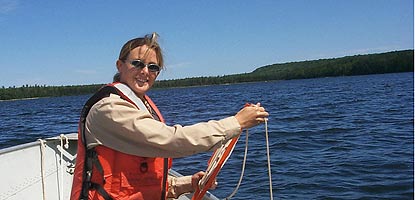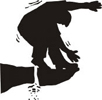 |
 | |
  | |
|
|
|
|
Pictured Rocks National Lakeshore
Your Safety
|
|
|
|
|
| |
 |

|
| NPS photo by Lora Loope |
| Boater wearing PFD. |
|
When you visit the lakeshore come prepared for a variety of weather, terrain, and unexpected situations.
|
 |
| Sandstone cliffs are unstable |
 |
The Pictured Rocks cliffs are spectacular but can be dangerous to the careless hiker. Fifteen miles of the North Country Trail are atop 50-200 foot high cliffs. Cliff tops are covered with loose sand and gravel. Unsupported overhangs of soft sandstone are common. For your safety, stay away from the cliff edge.
The weather near Lake Superior is very changeable. Summers are often warm but be prepared for cool, rainy, windy weather. Hypothermia can occur at any time; know the symptoms. Use a layered clothing system.
Canoeing and kayaking are great ways to see the Pictured Rocks, but can be extremely dangerous due to rapidly changing weather and lake conditions. Only experienced boaters with appropriate skills and equipment should canoe or kayak Lake Superior.
|
 |
| Sand tunnels may collapse! |
 |
Swimmers should be aware of .
Sand is unstable and may collapse. Do not build sand tunnels.
Be conservative with your trip itinerary so you can safely reach your next campsite. Always let someone know when you will return, whether for an extended backcountry trip or a day hike.
and other wildlife may be encountered in the backcountry. Keep a clean camp and exercise caution.
Black flies, mosquitoes, and stable flies can be a nuisance between late May and early September. Long pants and shirts and insect repellant are recommended.
The lakeshore is closed to hunting April 1 through Labor Day, but is open to hunting the rest of the year during small and large game seasons. A Michigan hunting license is required; state and federal regulations apply. Wear "hunter orange" during hunting seasons.
Do not count on your cell phone. Most areas of Pictured Rocks National Lakeshore do not have cellular coverage.
|
|  |  |
|
|

Poison ivy
is found at several places within the lakeshore.
more... | | 
Water, water everywhere
Is it safe to drink?
more... | | 
Boating safety
information from U.S. Coast Guard
more... | | 
Please don't
feed the bears
more... | |
|
|
|
|
|
|
|
 |
|
Did You Know?
Pictured Rocks National Lakeshore is home to three arctic disjuncts, plants whose normal range is far to the north. Arctic crowberry, Pitcher's thistle, and thimbleberry thrive because of the cool and moist microclimates caused by Lake Superior.
more...
|
|
|
|
Last Updated: March 20, 2008 at 16:03 EST |






